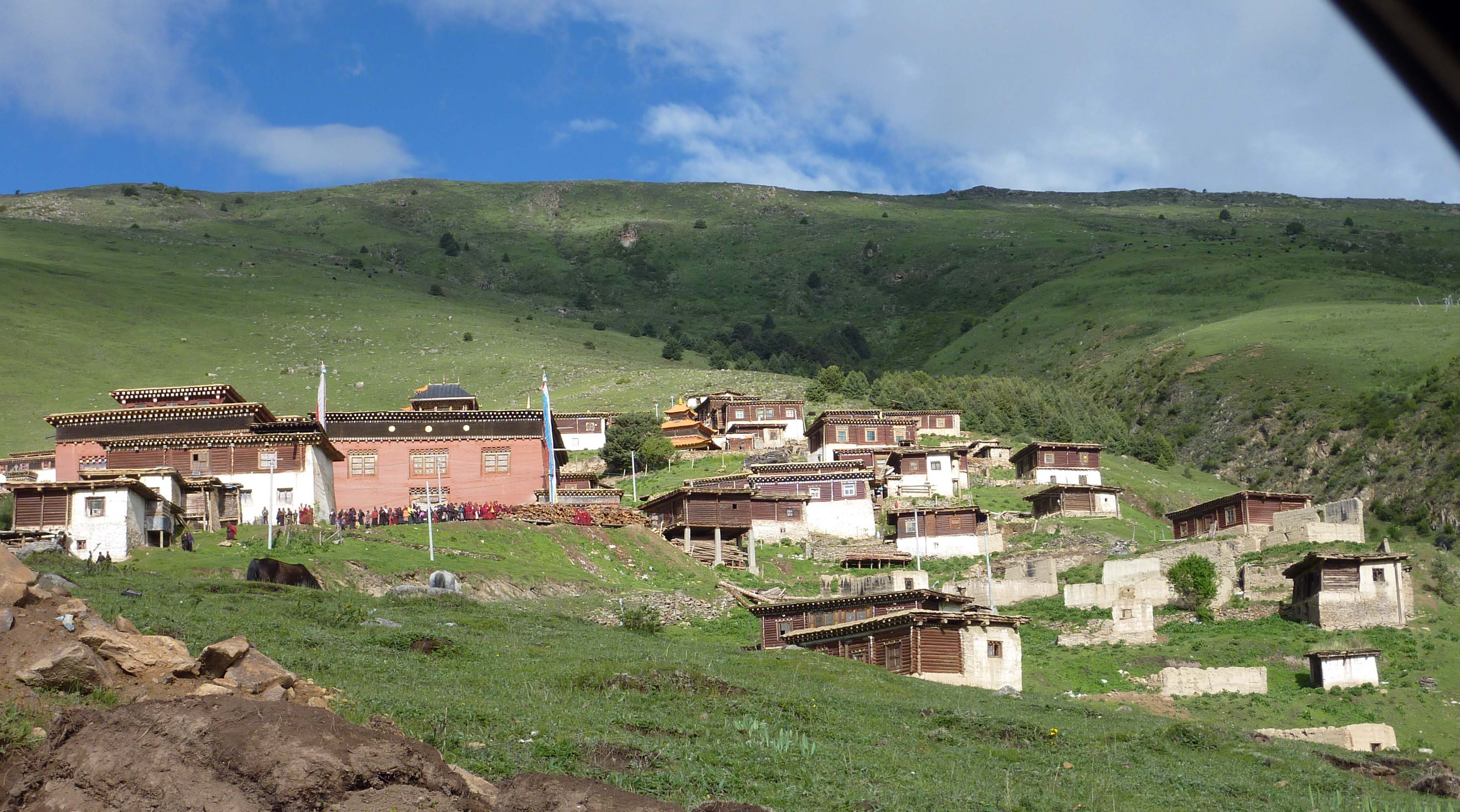ADZOM DRUKPA DRODÜL PAWO DORJE
1842 - 1924
Adzom Drukpa Drodül Pawo Dorje, also known as Natsok Rangtröl, was one of the greatest Dzogchen masters of the early twentieth Century, and one of the greatest lineage holders and propagators of the Longchen Nyingthig teachings.
He was born on the fifteenth day of the sixth month of the Water Tiger year (1842) in Tashi Dungkargang in the Tromtar / Tromkok region of Kham. Pawo Dorje's father was Adzom Sonam Gyatso, an accomplished practitioner, from a Mongol family background, and his mother was named Aga; she was the daughter of Adzi Adotsang. His parents had five daughters and four sons among whom Pawo Dorje was the second son.

Drime Zhingkyong Jigme Yonten Gonpo recognized him in infancy as the reincarnation of Adzom Rigdzin Sanggye Tashi. Also Drubtob Gyelwai Jangchub, a Drukpa Kagyu lama of Tromtar claimed that the child was also an incarnation of the Fourth Drukchen Pema Karpo (1527-1592), thus he became known as Adzom Drukpa. Despite the additional recognition, he did not become a lineage holder of the Drukpa Kagyu teachings. He was also said to be an incarnation of Ma Rinchen Chok, one of the first seven Tibetans to ordain as Buddhist monks in the eighth century.
Adzom Drukpa received his refuge vow from Shechen Öntrül Gyurme Thutop Namgyal; when he was thirteen, at Kathok Monastery, he received empowerments and instructions in the treasures of Longsel Nyingpo cycle from the first Katok Situ Chökyi Lödro. By practicing the ngöndro of Dorje Nyingpo, he developed a strong experience of the impermanence of life, and he emphasized his meditation on purification for a number of years. Then from Kathok Situ he received tsa-lung and Dzogpa Chenpo teachings. At the age of twenty-one, he realized the true nature of mind, the intrinsic Awareness. From then till the age of thirty-four, he concentrated on the meditation on dwelling in the realized nature of the intrinsic Awareness and reached the ultimate stage of attainment.
He served Nyakla Pema Düdül (1816-1872), who eventually attained the rainbow body, and this master instructed him to remain as a layman, let his hair grow long and wear the tantric dress. The advice to remain as a layman was repeated by Dzogchen Khenpo Pema Dorje (c.1807-1884), a disciple of DzaPatrul Orgyen Jigme Chokyi Wangpo. He accepted a girl called Tashi Lhamo, the daughter of a popular merchant for his wife, at the recommendation of Jamgön Kongtrul. He had two sons, Adzom Gyalse Gyurme Dorje (also known as Agyur Rinpoche, 1895 - 1959), who was educated mainly by him and later became a great Dzogpa Chenpo master and whose reincarnations continued his tradition, and Pema Wangyal, and a daughter, Semo Chi-med.
Chief among Adzom Drukpa's teachers were Jamyang Khyentse Wangpo and Patrul Rinpoche; trusted dharma-friend and contemporary to Jamgön Mipham, who taught him many of his own compositions. He received teachings and transmissions of many masters such as: Kathok Situ, Shechen Thutop Namgyal, Jamgön Kongtrul Lodro Thaye, Gyeltse Rigpai Reltri (1830-1896) a son of Do Khyentse Yeshe Dorje (1800-1866), Nyoshul Lungtok Tenpai Nyima, Kathok Moktsa Rinpoche, among others. Also received visions of Rigdzin Jigme Lingpa, whereby he was taught directly, and Khandro Yeshe Tsogyal.

Picture of Adzom Chögar - Tibet, by Adzom Gyalse Tulku.
2010
Throughout his later life he taught the great Lamas of Kathok, Dzogchen, Shechen, and Palyül monasteries. Among his main disciples were his sons Agyur Rinpoche, Pema Wangyal and his daughter Chime Wangmo, Khenpo Kunzang Pelden (1862-1943); Terton Sogyal Lerab Lingpa (1856-1926); the Third Katok Situ Orgyen Chokyi Gyatso, the Third Getse Gyurme Tenpa Namgyel (1886-1952); the Fourth Moktsa Jikdrel Chokyi Langpo; Tubten Gyeltsen Ozer; Jamyang Khyentse Chokyi Lodro (1893-1959); Choying Rangdrol (1872-1952); Drejongpa Tubten Chonyi, the Fifty-fourth Ngor Khenchen Kunga Tenpai Gyeltsen (1829-1870), Ayu Khadro Dorje Peldron (1839-1953), and Khunu Lama Tendzin Gyeltsen (1895-1977); besides 13 of his students were known to have achieved rainbow body.
At Shechen monastery, he came into close contact with the family of the young Dilgo Khyentse Tashi Peljor. Pawo Dorje took the young boy under his protection, administering the novice vows and clearing obstacles for his family.He edited and published many important Nyingma texts, including the complete writings and ter teachings of Longchen Rabjam and Jigme Lingpa.
He discovered many teachings as ter under the name of Ösal Dorje Sangdzö (Treasure of Vajra Luminosity). After taking up the life style of a Terton, he became an inheritor of hidden-treasure and prolific author. Thus he was one of the most important masters of Longchen Nyingtig lineage and essential link in the Nyingtig’s Oral-transmission of Yeshe Lama and Tsa-Lung.
In 1886 he established his main seat at Tashi Dungkar Khyil, the Auspicious Spiraling Conch Shell, popularly known as the Adzom Chögar, the Dharma Encampment of Adzom. During Adzom Drukpa's life it was largely a loosely organized encampment more than a formal monastery; today it is one of the larger monasteries in Tromtar, with a monastic college and a printing house, as well as a large central temple and other buildings.
On the third day of the twelfth month of the lunar year, or February/March 1924, he felt ill and his disciples there, at Adzom Chögar and elsewhere began extensive prayer to extend his life. He advised the disciples to study and practice Dzogchen and in the evening he shared some of his experiences of clear visions. It is said that on the night before he died, around midnight, people saw strange rays of light that did not reflect on surfaces; at the dawn he passed into nirvana with wondrous signs, at the age of eighty-three. His reincarnation, Druktrul Rinpoche (b. 1926) Thubten Pema Trinle was recognized by Adzom Gyalse Gyurme Dorje.
Sources:
http://www.treasuryoflives.org/biographies/view/Adzom-Drukpa-Pawo-Dorje/8574
Tulku Thondup. Masters of Meditation and Miracles: The Longchen
Nyingthig Lineage of Tibetan Buddhism. Boston: Shambhala,
1996.
